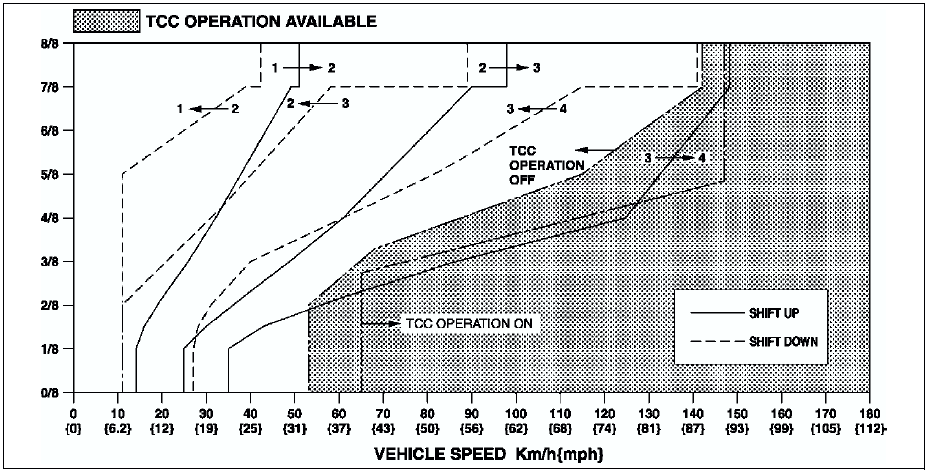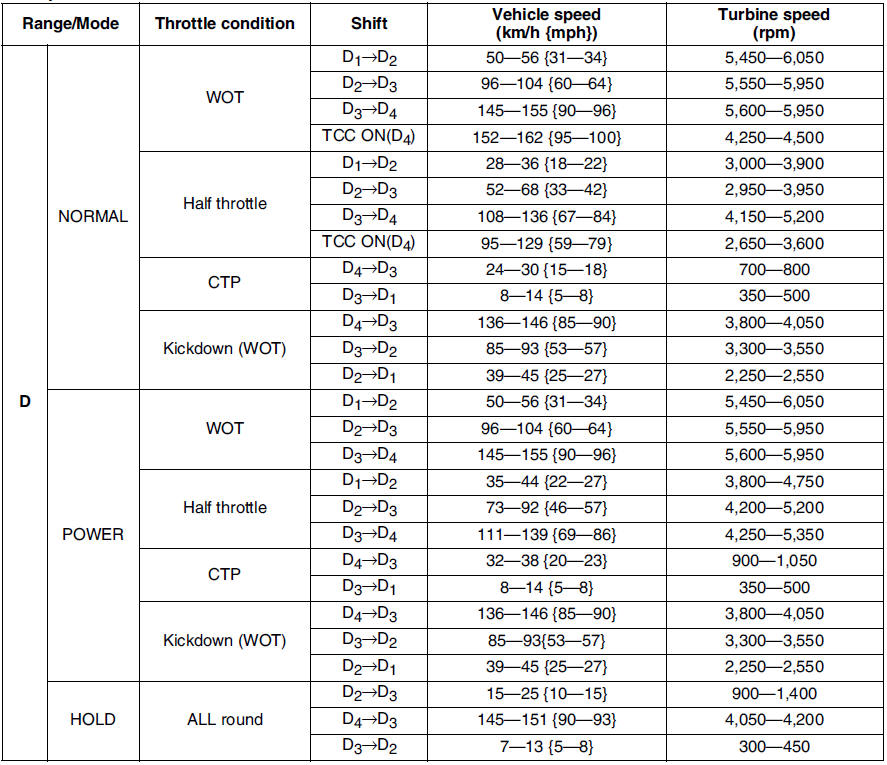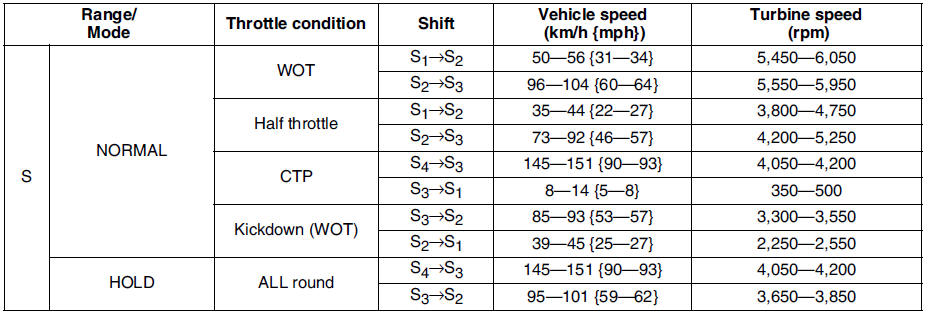Mazda 6 Service Manual: Road test
Warning
- When performing a road test, be aware of other vehicles, people, impediments, etc. to avoid an accident.
Note
- When the legal speed limit must be exceeded, use a chassis dynamomenter instead of performing a road test.
Road Test Preparation
1. Inspect the engine coolant levels. (See ENGINE COOLANT LEVEL INSPECTION.)
2. Inspect the engine oil levels. (See ENGINE OIL INSPECTION.)
3. Inspect the ATF levels. (See AUTOMATIC TRANSAXLE FLUID (ATF) INSPECTION.)
4. Inspect the idle speed and ignition timing in P position. (See IDLE SPEED INSPECTION.)(See IGNITION TIMING INSPECTION.)
5. Bring up the engine and transaxle to normal operating temperature.
Shift Diagram
D range (normal mode)

D Range Test
1. Perform road test preparation. (See Road Test Preparation.)
2. Shift the selector lever to D range.
3. Accelerate the vehicle with half and WOT, then verify that 1→2, 2→3, and 3→4 upshifts can be obtained. The shift points must be as shown in the table below.
- If not as specified, inspect the PCM and ATX. (See SYMPTOM TROUBLESHOOTING ITEM TABLE.)
4. Drive the vehicle in 4GR, 3GR, and 2GR and verify that kickdown occurs for 4→3, 3→2, 2→1 downshifts, and that the shift points are as shown in the table below.
- If not as specified, inspect the PCM and ATX.(See SYMPTOM TROUBLESHOOTING ITEM TABLE.)
5. Decelerate the vehicle and verify that engine braking effect is felt in 2GR, 3GR, and 4GR.
- If not as specified, inspect the PCM and ATX. (See SYMPTOM TROUBLESHOOTING ITEM TABLE.)
6. Drive the vehicle and verify that TCC operation is obtained. The operation points must be as shown in the table below.
- If not as specified, inspect the PCM and ATX. (See SYMPTOM TROUBLESHOOTING ITEM TABLE.)
7. Select HOLD mode.
8. Accelerate the vehicle at half throttle and WOT, and verify that 4→3, 3→2, and 2→3 shift can be obtained. The shift points must be as shown in the table below.
- If not as specified, inspect the PCM and ATX. (See SYMPTOM TROUBLESHOOTING ITEM TABLE.)
9. Drive the vehicle in 4GR, 3GR, 2GR and verify that kickdown does not occur.
- If not as specified, inspect the PCM and ATX. (See SYMPTOM TROUBLESHOOTING ITEM TABLE.)
10. Decelerate the vehicle and verify that engine braking effect is felt in 2GR, 3GR, and 4GR.
- If not as specified, inspect the PCM and ATX. (See SYMPTOM TROUBLESHOOTING ITEM TABLE.)
Shift point table

S Range Test
1. Perform road test preparation. (See Road Test Preparation.)
2. Shift the selector lever to S range.
3. Accelerate the vehicle at half throttle and WOT, then verify that 1→2 and 2→3 upshifts can be obtained. The shift points must be as shown in the table below.
- If not as specified, inspect the PCM and ATX. (See SYMPTOM TROUBLESHOOTING ITEM TABLE.)
4. Drive the vehicle in 2GR, 3GR, 4GR and verify that kickdown occurs for 4→3, 3→2, 2→1 downshift, and that the shift point is as shown in the table below.
- If not as specified, inspect the PCM and ATX. (See SYMPTOM TROUBLESHOOTING ITEM TABLE.)
5. Decelerate the vehicle and verify that engine braking effect is felt in 2GR, 3GR and 4GR.
- If not as specified, inspect the PCM and ATX. (See SYMPTOM TROUBLESHOOTING ITEM TABLE.)
6. Select HOLD mode.
7. Accelerate the vehicle in 2GR at half throttle and WOT, and verify that 2GR is held.
- If not as specified, inspect the PCM and ATX. (See SYMPTOM TROUBLESHOOTING ITEM TABLE.)
8. Decelerate the vehicle and verify that engine braking effect is felt.
- If not as specified, inspect the PCM and ATX. (See SYMPTOM TROUBLESHOOTING ITEM TABLE.)
Shift point table

L Range Test
1. Perform road test preparation. (See Road Test Preparation.)
2. Shift the selector lever to L range.
3. Accelerate the vehicle at half throttle and WOT, then verify that 1→2 upshift. The shift points must be as shown in the table below.
- If not as specified, inspect the PCM and ATX.(See SYMPTOM TROUBLESHOOTING ITEM TABLE.)
4. Drive the vehicle in 2GR and verify that kickdown occurs for 2→1 downshift, and that the shift point is as shown in the table below.
- If not as specified, inspect the PCM and ATX. (See SYMPTOM TROUBLESHOOTING ITEM TABLE.)
5. Decelerate the vehicle and verify that engine braking effect is felt in 1GR,2GR, 3GR and 4GR.
- If not as specified, inspect the PCM and ATX. (See SYMPTOM TROUBLESHOOTING ITEM TABLE.)
6. Select HOLD mode.
7. Accelerate the vehicle in 1GR at half throttle and WOT, and verify that 1GR is held.
- If not as specified, inspect the PCM and ATX. (See SYMPTOM TROUBLESHOOTING ITEM TABLE.)
8. Decelerate the vehicle and verify that engine braking effect is felt.
- If not as specified, inspect the PCM and ATX. (See SYMPTOM TROUBLESHOOTING ITEM TABLE.)
Shift point table

P Position Test
Shift into P position on a gentle slope. Release the brake and verify that the vehicle does not roll.
 Mechanical system test
Mechanical system test
Mechanical System Test Preparation
1. Engage the parking brake and use wheel chocks at the front and rear of the
wheels.
2. Inspect the engine coolant. (See ENGINE COOLANT LEVEL INSPECTION.)
3. I ...
 Automatic transaxle fluid (atf) inspection
Automatic transaxle fluid (atf) inspection
Automatic Transaxle Fluid (ATF) Condition Inspection
One way of determining whether the transaxle should be disassembled is by
noting:
If the ATF is muddy or varnished.
If the ATF smells stra ...
Other materials:
Mazda 6 Service Manual: Jacking positions ,vehicle lift (2 supports),safety stands (rigid rack)
positions
Jacking Positions
Warning
Improperly jacking a vehicle is dangerous. The vehicle can slip
off the jack and cause serious injury. Use only the correct front and rear
jacking points and block the wheels.
Use safety stands to support the vehicle after it has been lifted.
Fro ...
Mazda 6 Service Manual: Windshield Wipers and Washer
The ignition must be switched ON to use the wipers.
WARNING
Use only windshield washer fluid or plain water in the reservoir:
Using radiator antifreeze as washer fluid is dangerous. If sprayed on the windshield,
it will dirty the windshield, affect your visibility, and could result in an accid ...
